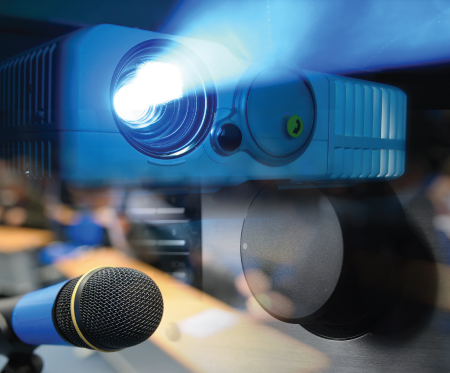How audio visual charlotte nc redefines atmosphere for maximum impact
Understanding the Inclusion of Audio Visual Technology in Today's Educational Environments
The assimilation of audio-visual technology in academic settings has actually changed the teaching and learning process. Educators currently have access to tools that deal with different learning designs, improving pupil interaction and partnership. The consolidation of these innovations provides both chances and challenges. Understanding how to effectively apply these tools is necessary. What approaches can instructors use to optimize the benefits of audio-visual modern technology in their class?
The Advancement of Audio-Visual Modern Technology in Education
As academic demands advanced over the decades, audio-visual modern technology went through significant makeovers that reshaped the learning atmosphere. At first, tools such as film projectors and slide shows were the key ways of integrating visual elements right into class. These very early modern technologies offered teachers with the capability to present info dynamically, yet they were limited in access and interactivity.
With the development of video clip cassette recorders in the 1970s, classrooms began to incorporate documented lessons, broadening the scope of instructional sources. The intro of computers in the 1980s further revolutionized this landscape, enabling for the production of multimedia discussions and interactive discovering experiences.
The increase of the internet in the 1990s marked a zero hour, allowing real-time accessibility to a wealth of audio-visual materials. Today, electronic devices such as interactive whiteboards and online knowing systems continue to improve the instructional experience, cultivating involvement and cooperation amongst students.
Benefits of Audio-Visual Devices for Diverse Learning Styles
Audio-visual tools play a crucial duty in satisfying diverse learning styles by improving visual knowing and boosting auditory involvement. By incorporating photos, videos, and sound, these modern technologies produce a more inclusive educational environment. This multifaceted approach permits instructors to deal with the different preferences and demands of trainees properly.
Enhancing Visual Understanding
Engagement in the discovering process is substantially boosted via using audio-visual devices, satisfying various learning designs. These devices, such as video clips, infographics, and interactive discussions, offer aesthetic stimulations that help comprehension and retention. Aesthetic students, particularly, gain from the consolidation of pictures and animations, which can simplify intricate concepts and enhance understanding. Furthermore, audio-visual sources can highlight real-world applications, making finding out extra appropriate and engaging. By integrating shade, movement, and noise, teachers can develop a dynamic knowing environment that records students' interest and cultivates deeper cognitive connections. Ultimately, the calculated use audio-visual technology not just supports visual learning but also enriches the total educational experience for varied learners.
Improving Auditory Interaction
A substantial benefit of integrating audio-visual devices in education is their capability to enhance acoustic involvement amongst trainees. These devices, which encompass multimedia presentations, podcasts, and interactive sound components, provide to various learning designs, specifically benefiting acoustic students (audio visual charlotte nc). By incorporating sound and narrative, educators can develop immersive experiences that record trainees' attention and strengthen comprehension. This engagement is essential, as it fosters a deeper understanding of the product and advertises retention. In addition, audio-visual devices can assist in joint understanding settings, urging pupils to get involved in discussions and share their insights. Inevitably, the incorporation of audio-visual technology not just sustains auditory interaction yet also enriches the general instructional experience, making discovering more vibrant and efficient for all trainees
Enhancing Interaction Via Interactive Learning

Furthermore, gamification elements, such as tests and simulations, can boost inspiration and retention, making discovering more pleasurable and reliable. These strategies not only promote cognitive involvement but likewise provide to diverse discovering designs, guaranteeing that all trainees can get involved meaningfully. Because of this, interactive discovering settings foster a feeling of area and belonging, inevitably resulting in enhanced scholastic end results. Via the integration of audio visual modern technology, instructors can change traditional classrooms into lively areas where students prosper and proactively form their academic journeys.
Connecting Concept and Exercise With Multimedia Resources
Multimedia sources act as a vital link in between theoretical concepts and practical application in educational settings. By improving involvement, assisting in joint understanding experiences, and supporting varied understanding styles, these devices create a much more inclusive and vibrant learning environment - audio visual charlotte nc. This strategy not only cultivates much deeper understanding but likewise prepares trainees for real-world obstacles

Enhancing Engagement Through Multimedia
Engagement in academic settings substantially raises when instructors integrate multimedia resources into their training approaches. Using video clips, podcasts, and interactive presentations improves the discovering experience, enabling pupils to attach with the product on numerous levels. Multimedia sources cater to different learning styles, providing visual, acoustic, and kinesthetic stimulations that can hold pupils' interest a lot more effectively than standard lecture techniques. Additionally, these resources can streamline complicated concepts, making them a lot more available and remarkable. By integrating multimedia, instructors can develop a dynamic classroom setting that fosters inquisitiveness and motivates students. Inevitably, the calculated use of audio-visual innovation offers to connect the void between academic knowledge and practical application, enhancing the instructional experience for both instructors and pupils.
Assisting In Collaborative Discovering Knowledge
Many studies indicate that collaborative knowing experiences noticeably enhance pupil end results when integrated with multimedia sources. Multimedia tools facilitate communication amongst pupils, enabling them to participate in analytic and important thinking jointly. By utilizing video conferencing, joint systems, and interactive discussions, instructors create settings favorable to synergy and shared knowing. These modern technologies make it possible for trainees to connect their ideas properly and get prompt feedback, promoting a much deeper understanding of the subject matter. In enhancement, multimedia explanation resources can offer complex ideas in even more absorbable formats, promoting conversation and collaboration. Consequently, the mix of collaborative discovering and audio-visual technology not only enhances the instructional experience but likewise prepares pupils for real-world synergy dynamics, emphasizing the value of participation and cumulative expertise construction.
Supporting Diverse Knowing Styles
While standard training approaches typically accommodate a restricted range of learning choices, the assimilation of audio-visual innovation supplies a more comprehensive strategy to education. By employing multimedia sources such as video clips, interactive simulations, and digital presentations, instructors can attend to different learning designs, including aesthetic, auditory, and kinesthetic. This versatility allows for differentiated guideline, allowing pupils to involve with content in manner ins which resonate with their individual preferences. Additionally, audio-visual devices can promote much deeper understanding by supplying numerous representations of complicated principles. Because of this, trainees who may have problem with traditional techniques can find alternate paths to success, cultivating a much more equitable learning setting that sustains scholastic success for all learners.
Difficulties in Executing Audio-Visual Technology
Audio-visual innovation holds excellent pledge for enhancing educational experiences, its application typically comes across considerable difficulties. One key issue is the economic problem connected with investing in and preserving such tools, which can strain spending plans, especially in underfunded institutions. Furthermore, insufficient training for teachers can prevent reliable assimilation, leaving them ill-prepared to use the innovation totally. Technical issues, such as software application breakdowns and compatibility troubles, might likewise interfere with lessons and frustrate both instructors and trainees. Moreover, varying levels of student accessibility to modern technology outside the class can develop differences in finding out possibilities. The possibility for over-reliance on technology might take away from essential teaching methods, ultimately restricting the educational experience. Attending to these challenges requires a comprehensive strategy, including ample funding, professional development, and fair accessibility to sources, to assure that audio-visual modern technology can be leveraged effectively in today's instructional setups.
Finest Practices for Integrating Technology in the Class

Additionally, promoting an interactive setting via collaborative tools motivates trainee involvement and participation. Using diverse audio-visual resources deals with different discovering designs, suiting aesthetic, acoustic, and kinesthetic students. Consistently evaluating the effect of innovation on pupil understanding helps teachers improve their approaches and adapt to changing requirements. Entailing trainees in the option of modern technology advertises possession and inspiration. By sticking to these best practices, teachers can develop a dynamic class ambience that properly integrates modern technology and improves the academic experience for all pupils.
The Future of Audio-Visual Modern Technology in Education And Learning
As class progressively welcome modern technology, the landscape of audio-visual devices in education and learning remains to evolve (audio visual charlotte nc). Future improvements are expected to concentrate on better interactivity and customization, permitting educators to tailor discovering experiences to specific pupil demands. Developments such as augmented reality (AR) and digital fact (VIRTUAL REALITY) will likely supply immersive discovering settings, enhancing helpful hints student engagement and understanding
Fabricated intelligence (AI) is positioned to play a significant function in audio-visual technology by supplying real-time responses and adaptive understanding pathways. This combination might help teachers determine and resolve student difficulties better. Cloud-based systems will help with less complicated accessibility to resources and partnership amongst pupils and teachers, regardless of place.
Along with these technological advances, expert growth for instructors will certainly be important, guaranteeing they are outfitted to utilize these devices effectively. In general, the future of audio-visual technology in education guarantees to create more dynamic, comprehensive, and impactful learning experiences.
Often Asked Questions
Just How Can Teachers Select the Right Audio-Visual Tools for Their Classrooms?
Choosing proper audio-visual devices requires educators to assess their academic objectives, take into consideration pupil needs, evaluate offered technology, and look for recommendations from peers or experts, top article making certain tools properly enhance knowing and engagement within their particular classroom environment.
What Budget Considerations Are There for Executing Audio-Visual Technology?
Budget plan factors to consider for carrying out audio-visual innovation include preliminary purchase prices, maintenance expenditures, training for team, and possible software licensing costs. In addition, lasting financial investment in updates and substitutes need to additionally be factored right into economic planning.
Are There Specific Training Resources for Educators on Audio-Visual Tools?
Many institutions supply training sources for instructors on audio-visual tools, consisting of on the internet programs, workshops, and instructional overviews. These sources aim to boost teachers' abilities and confidence in effectively integrating technology right into their mentor practices.
Just how Do We Determine the Performance of Audio-Visual Innovation in Understanding?
Determining the effectiveness of audio-visual modern technology in learning entails assessing pupil interaction, understanding, retention prices, and total academic efficiency. Surveys, evaluations, and empirical research studies can offer beneficial understandings right into its influence on instructional end results.
What Are Common Misconceptions Concerning Audio-Visual Modern Technology in Education?
Usual misconceptions concerning audio-visual technology in education include the belief that it guarantees interaction and discovering outcomes, in addition to the presumption that all students benefit just as, ignoring individual understanding preferences and needs.